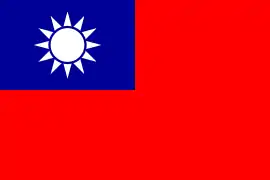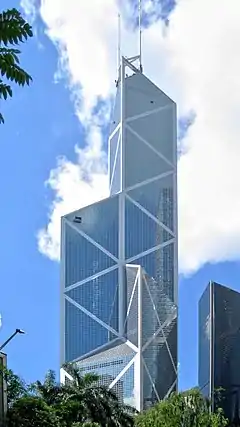T. V. Soong
Soong Tse-vung, more commonly romanized as Soong Tse-ven or Soong Tzu-wen (Chinese: 宋子文; pinyin: Sòng Zǐwén; December 4, 1894 – April 25, 1971) was a prominent businessman and politician in the early-20th-century Republic of China. His father was Charlie Soong and his siblings were the Soong sisters. His Christian name was Paul, but he is generally known in English as T. V. Soong. As brother to the three Soong sisters, Soong's brothers-in-law were Dr. Sun Yat-sen, Generalissimo Chiang Kai-shek, and financier H. H. Kung.
T. V. Soong | |
|---|---|
宋子文 | |
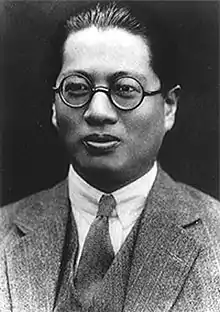 | |
| Premier of the Republic of China | |
| In office 31 May 1945 – 1 March 1947 | |
| President | Chiang Kai-shek |
| Preceded by | Chiang Kai-shek |
| Succeeded by | Chiang Kai-shek (acting) |
| In office 25 September 1930 – 4 December 1930 Acting | |
| President | Chiang Kai-shek |
| Preceded by | Tan Yankai |
| Succeeded by | Chiang Kai-shek |
| Personal details | |
| Born | Soong Tse-vung December 4, 1894 Shanghai, Qing Dynasty |
| Died | April 25, 1971 (aged 76).[1] San Francisco, California, United States |
| Resting place | Ferncliff Cemetery and Mausoleum, Hartsdale, Westchester County, New York, USA |
| Nationality | Republic of China |
| Political party | Kuomintang |
| Spouse(s) | Lo-Yi Chang |
| Parents | Charlie Soong and Nyi Kwei-twang (Ni Kwei-tseng) |
| Alma mater | Harvard University Columbia University |
Early life and education
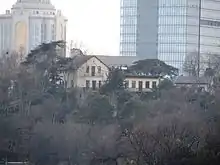
Born in Shanghai, T. V. Soong received his education at St. John's University in Shanghai before completing a bachelor's degree in economics from Harvard University in 1915. He worked at the International Banking Corporation in New York while pursuing graduate studies at Columbia University.[2]
Career
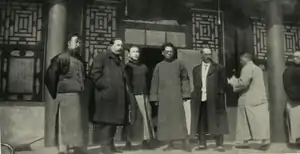
Upon returning to China he worked for several industrial enterprises, and was then recruited by Sun Yat-sen to develop finances for his Canton government. After the success of Chiang Kai-shek's Northern Expedition in 1927, Soong served in a succession of offices in the Nationalist Government,[3] including governor of the Central Bank of China (1928–1934) and minister of finance (1928–1933).[4]
He founded the China Development Finance Corporation (CDFC) in 1934, along with other prominent financial figures, such as Chang Kia-ngau, Chen Guangpu and H.H. Kung. CDFC provided China's chief access to foreign investment for the next decade. In summer of 1940, Chiang appointed Soong to Washington as his personal representative. His task was to win support for China's war with Japan. Soong successfully negotiated substantial loans for this purpose. Also, while in Washington in 1940, Soong managed to prevail upon President Roosevelt and his administration to back the plan of then-retired U.S. Col. Claire Lee Chennault to firebomb Japanese cities with Boeing B-17 bombers painted with Chinese Air Force markings and flown by American pilots from airbases in China, before the Japanese attack on Pearl Harbor. A scant month before the Pearl Harbor attack, the plan was scotched by U.S. Army Chief of Staff General George C. Marshall. After Pearl Harbor, Chiang appointed Soong Minister of Foreign Affairs, though Soong remained in Washington to manage the alliance with both the U.S. and the U.K.
During his tenure as Finance Minister, he managed to balance China's budget, no small accomplishment. He resigned in 1933, displeased with Chiang Kai-shek's appeasement of Japan and attempts to placate Japanese aggression.[5] He later returned to service as Minister of Foreign Affairs (1942–1945), and as President of the Executive Yuan (1945–1947). Soong left his legacy as head of the Chinese delegation to the United Nations Conference on International Organization in San Francisco, April 1945, which later became the United Nations.
Soong was in charge of negotiating with the Soviet leader Joseph Stalin regarding Soviet interests in China, and traveled to Moscow to extract from Stalin a guarantee to oppose the Chinese Communist Party. Soong conceded to Stalin the Manchurian railways and Korean independence, but refused to allow Russian interference in Xinjiang or Russian military bases in Manchuria; he also indicated that China and the Soviet Union could share dominion over Mongolia if a "mutual assistance pact" was agreed to.[6] Soong was known for his tough negotiating style with Stalin, getting straight to the point and freely using the threat of American military backing to strengthen his demands. When the Sino-Soviet treaty was signed, China ceded to Russia parts of Mongolia, use of a naval base at Port Arthur (with civilian rule remaining Chinese), and co-ownership of the Chinese Eastern Railway in Manchuria.[7]:1 In return, Soong extracted from Stalin recognition of the Republic of China as the legitimate regime of China, aid from the Soviets, and oral agreement to an eventual Soviet withdrawal from Manchuria.[7]:2 The treaty failed to end tension in China with the communists, resulting in renewed fighting in the Chinese Civil War.[8] Stalin had previously told the Americans that President Roosevelt should inform Chiang Kai-shek of the Russian demands in Manchuria, at the Yalta Conference, before Stalin informed Soong.[9]
During the war years, he financed the "Flying Tigers"—the American mercenary group that was later incorporated into the United States Air Force. Gen. Claire Chennault was listed as an employee of the Bank of China. On this project Soong worked very closely with his sister, Madame Chiang Kai-shek (May-ling Soong). He once remarked to John Paton Davies, Jr., one of the China Hands, that there were no U.S. State Department memos sent from China that he did not have access to within a few days.[10][11]:241
Death
After the defeat of the Nationalists in the Chinese Civil War, Soong moved to New York and remained an influential member of the China Lobby.[11]:317 On April 25, 1971, Soong choked to death in San Francisco at a dinner party hosted by the chairman of the San Francisco branch of the Bank of Canton, when a piece of chicken lodged in his windpipe.[12] Soong was survived by his widow, Lo-Yi Chang (張樂怡 Zhāng Lèyí), who had taken on the American name of Laura Chang Soong.
See also
References
- Notes
- "Ex-Premier of China, Soong, Dies in S.F.", San Mateo Times, April 26, 1971, p2. From the article in the Monday paper, Soong "died here Sunday night"
- Kuo, Tai-chun; Lin, Hsiao-ting (2003). T.V. Soong in Modern Chinese History (PDF). Stanford University: Hoover Institution Press.
- "Soong, T.V.," Boorman Vol 3, p. 149.
- "Foreign News: Chiang's Cabinet". Time. October 29, 1928. Retrieved May 22, 2011.
- "CHINA: Soong Out". Time. November 6, 1933. Retrieved May 22, 2011.
- "CHINA: Top Secret". Time. July 30, 1945. Retrieved June 6, 2011.
- "THE NATIONS: Light in the East". Time. September 3, 1945. Retrieved June 6, 2011.
- "Foreign News: REPORT ON CHINA". Time. November 19, 1945. p. 1. Retrieved June 6, 2011.
- "HISTORICAL NOTES: We Believed in Our Hearts". Time. September 13, 1948. p. 1. Retrieved June 6, 2011.
- John P. Davies, Dragon by the Tail, p.266.
- Halberstam, David (2008). The Coldest Winter: America and the Korean War. Hachette Books. ISBN 978-0786888627.
- "Soong Choked to Death on Food, Coroner Says", Los Angeles Times, April 27, 1971, p28
- Bibliography
- Halberstam, David (2007). The Coldest Winter: America and the Korean War. New York: Hyperion. ISBN 978-1-4013-0052-4.
- Boorman, Howard (1967). Biographical Dictionary of Republican China. New York: Columbia University Press. ISBN 0-231-08957-0.
Seagrave, Sterling (April 19, 1986). The Soong Dynasty. Harper Perennial. ISBN 0-06-091318-5.
External links
| Wikimedia Commons has media related to T. V. Soong. |
- T.V. Soong Papers at the Hoover Institution Archives
- Newspaper clippings about T. V. Soong in the 20th Century Press Archives of the ZBW
| Government offices | ||
|---|---|---|
| Preceded by Tan Yankai |
Premier of the Republic of China 1930 |
Succeeded by Chiang Kai-shek |
| Preceded by Chiang Kai-shek |
Premier of the Republic of China 1945–1947 |
Succeeded by Chiang Kai-shek |

